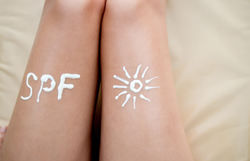25 January 2024
Understanding UV Light Therapies, Tanning Beds & Psoriasis
Ultraviolet (UV) light therapy is a longstanding treatment for psoriasis, involving two main types: Narrowband UVB and PUVA. This article explains how they work, addresses the use of tanning beds and covers general safety in the sun. UV light reduces skin inflammation, which makes it effective in treating psoriasis and other inflammatory skin conditions.
Sunbeds, Sunlamps and Natural Sunlight
It’s essential to highlight, using a sunbed, tanning bed or an at-home lamp is not the same as having hospital-based UV therapy.
Hospital-based UV treatment uses only the specific part of the spectrum which treats skin conditions. Whereas a sunbed uses a much broader spectrum. Many sunbeds use mostly, or entirely, UVA light, which is ineffective for treating psoriasis without the addition of a chemical called psoralen.
Therefore, using sunbeds increases the risks of UV exposure, without the benefits of treating psoriasis.
UV treatment in hospital is extremely well-controlled and monitored.
A dermatologist will tailor the treatment to each individual and administer accordingly. If a person uses sunbeds or an at-home lamp in addition to this, it makes it difficult to ensure they are receiving the correct dosage.
When is UV Therapy Used?
The National Institute for Health and Care Excellence (NICE), recommends UVB therapy for plaque or guttate psoriasis which cannot be treated by topical treatments. PUVA is considered for palmoplantar pustulosis.
Two Main Types of UV Therapy:
Narrowband UBV Treatment
Narrowband UVB (sometimes known as TL-01) is used for widespread guttate and plaque psoriasis which is unresponsive to topical treatments. Administered in a hospital phototherapy unit, the treatment is tailored to each individual by a dermatologist. The individual stands in the UVB cabinet for a period of a few seconds to several minutes at a time.
Sessions, which involve controlled exposure, are given two or three times a week, for up to ten weeks.
PUVA Treatment
Combining UVA light with psoralen (a chemical derived from plants) treats moderate to severe plaque psoriasis. It's effective on thicker plaques, administered in a phototherapy unit, with treatment typically taking twice a week for five to eight weeks.
Protective goggles should be worn during treatment and for up to 24 hours after. During the session, any areas untreated must be covered. Psoralen makes both the skin and the eyes more sensitive to UVA, so protective measures are necessary.
Risks and Side Effects of UV Therapy
Exposure to UV light (A or B) poses risks like skin damage, premature ageing and increases the danger of skin cancer. However, it’s important to note that these risks are also associated with exposure to natural sunlight. For these reasons, the British Photodermatology Group have issued guidelines regarding the total number of UV treatments an individual can receive in a lifetime.
Redness and tanning are common, therefore it’s essential to be aware of any burning sensations and inform a medical professional. UV treatment may cause dryness and itching, use of a moisturiser is highly encouraged. Oral Psoralen in PUVA can induce nausea which requires medical attention.
Safety Advice
Even if sunshine improves your psoriasis, being safe in the sun is paramount. When exposed to sunlight it’s important to wear sunscreen with high SPF (the NHS recommends SPF 15 or above) and re-apply it regularly. Other measures include covering up with a hat, t-shirt and sunglasses, and avoiding the most intense hours of sunlight in the middle of the day.
Sunburn can aggravate psoriasis or trigger a flare, so it’s important to follow the above advice.
In summary, UV therapies offer relief for psoriasis, but vigilant monitoring and adherence to safety guidelines are crucial to mitigate potential risks and side effects. Using a tanning bed or sunbed is not the same as receiving exposure-controlled UV therapy administered by a dermatologist.
For more information, download our UV treatment information sheet.

